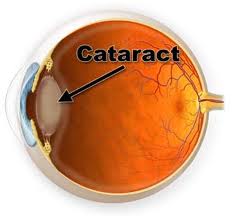There are many myths about cataracts, here are the facts:
- Cataracts cause blindness. While it is true that cataracts can cause severe vision loss and even blindness if left untreated, in most cases vision can be fully restored by cataract surgery. In fact, people who have needed prescription eyeglasses most of their life often see better without glasses after cataract surgery.

- Only older people get cataracts. Though the risk for the most common type of cataract increases as we get older, cataracts can occur at any age – even among children. Cataracts developing at an early age can be caused by heredity, certain diseases, medications or eye injuries.
- A cataract is a film that grows on the front of the eye. Actually, a cataract is the clouding of the lens inside the eye that is located behind the iris (colored part of the eye) and the pupil. The eye’s natural lens consists primarily of water and protein. When something affects the normal arrangement of protein in the lens, the lens becomes cloudy and causes blurry vision.
- There is nothing you can do to prevent cataracts. You may not be able to prevent some types of cataracts – such as those caused by an eye injury – but you can reduce your risk of some of the more common types by choosing a healthful diet, protecting your eyes from the sun’s UV rays, exercising regularly, maintaining a healthy weight and avoiding smoking.
- Cataracts have to be fully developed or “ripe” before they can be removed. Cataracts can be removed at any stage. The best time to remove the cloudy crystalline lens (cataract) is when the vision is compromising your quality of life. This includes the inability to drive at night due to excessive glare.
- Cataract surgery is dangerous. Modern cataract surgery is one of the safest operations performed today. More than 95% of cataract procedures are successful and fewer than 5% of patients have complications such as inflammation, bleeding, infection and retinal detachment, according to the Prevent Blindness America. In most cases, no stitches are required and it’s safe to return to work after a day of rest.
To read more about cataract, click here.